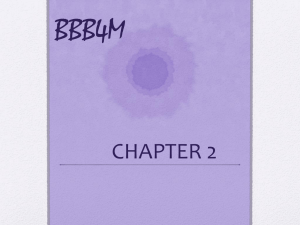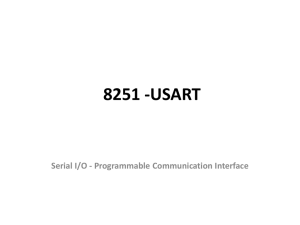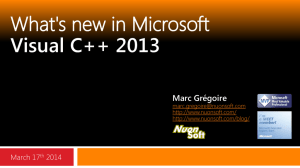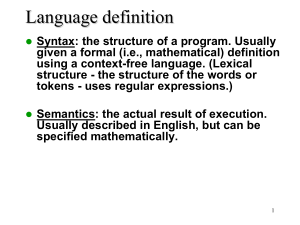6-Input & Output Instructions-ch4
advertisement
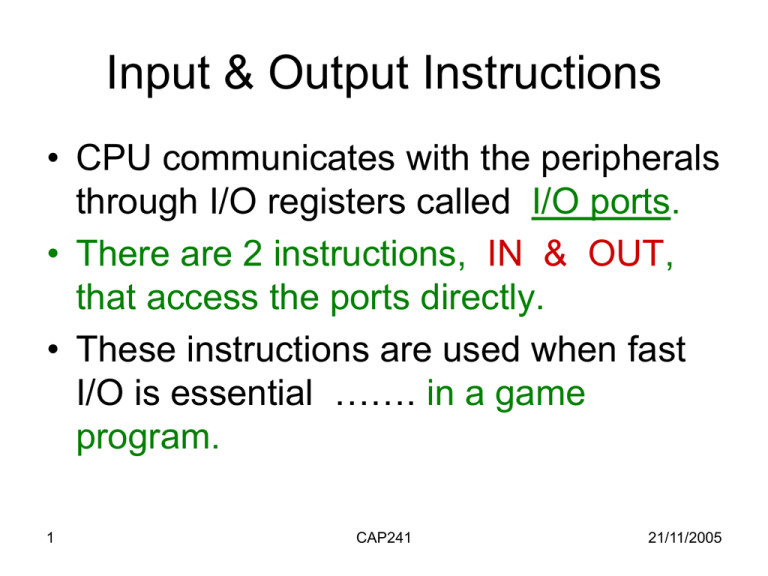
Input & Output Instructions • CPU communicates with the peripherals through I/O registers called I/O ports. • There are 2 instructions, IN & OUT, that access the ports directly. • These instructions are used when fast I/O is essential ……. in a game program. 1 CAP241 21/11/2005 IN & OUT • Most application programs do not use IN and OUT instructions. • Why? 1) port addresses vary among computer models 2) easier to program I/O with service routines 2 CAP241 21/11/2005 2 categories of I/O service routine 1. The BIOS routines. 2. The DOS routines. 3 CAP241 21/11/2005 BIOS routines • Are stored in ROM and interact directly with I/O ports. • Used to carry basic screen operations such as moving the cursor & scrolling the screen. 4 CAP241 21/11/2005 DOS routines • Can carry out more complex tasks. • Printing a character string…. They use the BIOS routines to perform direct I/O operations. 5 CAP241 21/11/2005 The INT Instruction. • To invoke a DOS or BIOS routine , the INT (interrupt) instruction is used. • FORMAT INT interrupt_number is a number that specifies a routine. 6 CAP241 21/11/2005 Example • INT 16h invokes a BIOS routine that performs keyboard input. • We will use a particular DOS routine INT 7 21h CAP241 21/11/2005 INT 21h • Used to invoke a large number of DOS functions. • Put the function number in AH register and then invoke INT 21h 8 CAP241 21/11/2005 FUNCTIONS Function number 9 Routines 1 single-key input 2 single-character output 9 character string output CAP241 21/11/2005 INT 21h functions • Input values are to be in certain registers & return output values in other registers. 10 CAP241 21/11/2005 Function 1 • Single-Key Input Input : AH = 1 Output : AL = ASCII code if character key is pressed. = o if non-character is pressed. 11 CAP241 21/11/2005 Example 12 MOV AH,1 ; input key function INT 21h CAP241 ; ASCII code in AL 21/11/2005 Example • If character k is pressed, AL gets its ASCII code; the character is also displayed on the screen • If Arrow key or F1-F10, AL will contain 0 • The instructions following the INT 21h can examine AL and take appropriate action. 13 CAP241 21/11/2005 Function 2 • INT 21h, function 1 …. doesn’t prompt the user for input, he might not know whether the computer is waiting for input or it is occupied by some computation. • Function 2 can be used to prompt the user 14 CAP241 21/11/2005 Function 2 • Display a character or execute a control function Input : AH = 2 DL = ASCII code for the display character or control character Output : AL = ASCII code of the display character or control character 15 CAP241 21/11/2005 Example MOV AH,2 ; display character function MOV DL, ‘?’ ; character is ‘?’ INT 21h ; display character • After the character is displayed, the cursor advances to the next position on the line. 16 CAP241 21/11/2005 Control functions • Function 2 may also be used to perform control functions. • If DL contains the ASCII code of a control character, INT 21h causes the control function to be performed. 17 CAP241 21/11/2005 Control functions ASCII code (hex) Symbol Function 7 BEL beep 8 BS backspace 9 HT tab A LF line feed (new line) D CR carriage return (start of current line) 18 CAP241 21/11/2005 A First Program Read a character and display it at the beginning of the next line 1-We start by displaying a question mark: MOV AH,2 ; display character function MOV DL,'?‘ ; character is ‘?’ INT 21H ; display character Move 3Fh, the ASCII code for “?” , into DL 19 CAP241 21/11/2005 Read a character 20 MOV AH,1 ; read character function INT 21H ; character in AL CAP241 21/11/2005 Display the character on next line • First , the character must be saved in another register. MOV BL , AL ; save it in BL • This because the INT 21h , function 2 , changes AL 21 CAP241 21/11/2005 Display the character on next line -Move cursor to the beginning of the next line: • Execute carriage return & line feed. • Put their ASCII codes in DL & execute INT 21h. 22 CAP241 21/11/2005 Move cursor to the beginning of the next line 23 MOV AH , 2 ; display character function MOV DL , 0Dh ; carriage return INT 21h ; execute carriage return MOV DL , 0Ah ; line feed INT 21h ; execute line feed CAP241 21/11/2005 Display the character 24 MOV DL , BL ; get character INT 21h ; and display it CAP241 21/11/2005 Program Listing TITLE PGM4_1 : Echo PROGRAM .MODEL SMALL .STACK 100H .CODE MAIN PROC ;display prompt MOV AH,2 MOV DL,'?' INT 21H ; input a character MOV AH,1 INT 21H MOV BL,AL 25 CAP241 ; go to a new line MOV AH,2 MOV DL,0DH INT 21H MOV DL,0AH INT 21H ; display characters MOV DL,BL INT 21H ; return to DOS MOV AH,4CH INT 21H MAIN ENDP END MAIN 21/11/2005 When a program terminates, it should return control to DOS 26 MOV AH,4CH ; DOS exit function INT 21H ; exit to DOS CAP241 21/11/2005 Displaying a string INT 21h , Function 9: Display a string Input : DX = offset address of string. The string must end with a ‘$’ character. 27 CAP241 21/11/2005 • If the string contains the ASCII code of a control character , the control function is performed. 28 CAP241 21/11/2005 Example • Print MSG 29 HELLO! on the screen. DB ‘HELLO!$’ CAP241 21/11/2005 The LEA instruction • INT 21h, function 9, expects the offset address of the character string to be in DX. • To get it there, we use LEA 30 destination , source CAP241 21/11/2005 LEA • • • • 31 destination , source LEA ….. Load Effective Address Destination … is a general register. Source ………… is a memory location. It puts a copy of the source offset address into destination. CAP241 21/11/2005 Example MSG LEA DB ‘HELLO!$’ DX , MSG ; puts the offset ;address of variable ; MSG in DX • This example contains data segments initialize DS. 32 CAP241 21/11/2005 Program Segment Prefix • When a program is loaded in memory, DOS prefaces it with PSP. The PSP contains information about program. • DOS places in DS & ES segment # of PSP. • DS must be loaded with the segment # of data segment 33 CAP241 21/11/2005 DS initialization • A program containing a data segment begins with: MOV AX,@DATA MOV DS,AX • @Data is the name of the data segment defined by .DATA. It is translated into a segment #. 34 CAP241 21/11/2005 Print the message • With DS initialized, we may print the “HELLO!” message: LEA MOV INT 35 DX,MSG ;get message AH,9;display string function 21h ;display string CAP241 21/11/2005 Sample Program directive giving title for printed listings program title (comment) TITLE PGM4-2: PRINT STRING PROGRAM ; This program displays “Hello!” comment line .MODEL SMALL .STACK 100H memory model: small programs use at most 64K code and 64K data set the stack size 36 CAP241 21/11/2005 Sample Program starts the data segment where variables are stored reserve room for some bytes carriage return and line feed .DATA MSG DB “HELLO!”,0DH,0AH,’$’ variable name starts the code segment .CODE Declares the beginning of the procedure which is MAIN PROC MOV AX,@DATA called main MOV DS,AX ;initialize DS LEA DX,MSG ;get message MOV AH,9 ;display string function INT 21H ;display message MOV AH,4CH INT 21H ;DOS exit marks the end of the current procedure MAIN ENDP marks the end of the program. “main” specifies END MAIN the program execution is to begin with the procedure “main” 37 CAP241 21/11/2005 • Sample execution: A> PGM4_2 HELLO! 38 CAP241 21/11/2005 Case Conversion Program ENTER A LOWER CASE LETTER : a IN UPPER CASE IT IS : A 39 CAP241 21/11/2005 Case Conversion Program • Use EQU to define CR & LF as names for the constants 0DH & 0AH. CR EQU LF EQU 40 0DH 0AH CAP241 21/11/2005 The messages and input character can be stored in the Data Segment like this: MSG1 MSG2 CHAR 41 DB DB DB 'ENTER A LOWER CASE LETTER : $‘ CR,LF , 'IN UPPER CASE IT IS : ‘ ?,'$' CAP241 21/11/2005 Our program begins by displaying the first message and reading the character: LEA MOV INT MOV INT 42 DX,MSG1 AH,9 21H AH,1 21H ; get first message ; display string function ;display first message ; read character function ; read a small letter into AL CAP241 21/11/2005 Convert to upper case SUB AL,20H ; convert into uppercase MOV CHAR,AL ; and store it 43 CAP241 21/11/2005 Display second message & uppercase LEA DX,MSG2 ; get second message MOV AH,9 ; display string function INT 21H ;display message & uppercase letter 44 CAP241 21/11/2005 Program Listing 45 CAP241 21/11/2005 .MODEL SMALL .STACK 100H ; input a character and .DATA convert to upper case CR EQU 0DH MOV AH,1 LF EQU 0AH INT 21H MSG1 DB 'ENTER A LOWER CASE LETTER : $' SUB AL,20H MSG2 DB CR,LF,'IN UPPER CASE IT IS : ' MOV CHAR,AL CHAR DB ?,'$' ; display on the next line .CODE LEA DX,MSG2 MAIN PROC MOV AH,9 ; initialize DS INT 21H MOV AX,@DATA ; return TO DOS MOV DS,AX MOV AH,4CH INT 21H ;print user prompt MAIN ENDP LEA DX,MSG1 END MAIN MOV AH,9 INT 21H 46 CAP241 21/11/2005
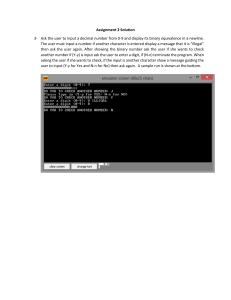


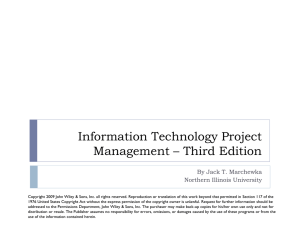

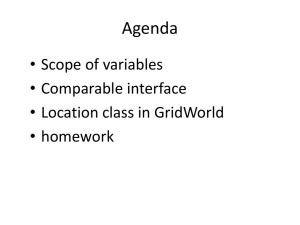
![Kaikoura Human Modification[1]](http://s2.studylib.net/store/data/005232493_1-613091dcc30a5e58ce2aac6bd3fb75dd-300x300.png)
